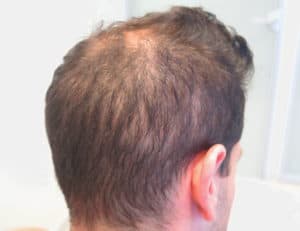Norwood Classification
The Norwood system of classification, published in 1975 by Dr. O’tar Norwood, is the most widely used classification for hair loss in men. It defines two major patterns and several less common types. In the regular Norwood pattern, two areas of hair loss gradually enlarge to produce recession at the temples and thinning in the crown. These regions coalesce until the entire front, top and crown (vertex) of the scalp are bald.
Click “View Photos” to view examples of patients from that Norwood Class.
| Class | Description | Image |
|---|---|---|
| Class I | Represents an adolescent or juvenile hairline and is not actually balding. The adolescent hairline generally rests on the upper brow crease. |  |
| Class II | Indicates a progression to the adult or mature hairline that sits a finger’s breath (1.5cm) above the upper brow crease, with some temporal recession. This also does not represent balding. |  |
| Class III | The earliest stage of male hair loss. It is characterized by a deepening temporal recession. |  View Photos View Photos |
| Class III Vertex | Represents early hair loss in the crown (vertex). |  View Photos View Photos |
| Class IV | Characterized by further frontal hair loss and enlargement of vertex, but there is still a solid band of hair across the top (mid-scalp) separating front and vertex. |  View Photos View Photos |
| Class V | The bald areas in the front and crown continue to enlarge and the bridge of hair separating the two areas begins to break down. |  View Photos View Photos |
| Class VI | Occurs when the connecting bridge of hair disappears leaving a single large bald area on the front and top of the scalp. The hair on the sides of the scalp remains relatively high. |  View Photos View Photos |
| Class VII | Patients have extensive hair loss with only a wreath of hair remaining in the back and sides of the scalp. |  View Photos View Photos |
Norwood Class A
The Norwood Class A patterns are characterized by a predominantly front to back progression of hair loss. These patterns lack the connecting bridge across the top of the scalp and generally have more limited hair loss in the crown, even when advanced.
The Class A patterns are less common than the regular pattern (less than 10%), but are significant because when hair loss is in the front, patients can look very bald even if their hair loss is minimal. Men with Class A hair loss often seek surgical hair restoration early, as the frontal bald area is not as responsive to medication and the dense donor area contrasts and accentuates the baldness on top. Fortunately, Norwood Class A patients are excellent candidates for hair transplantation.
Click “View Photos” to view examples of patients from that Norwood Class.
| Class | Description | Image |
|---|---|---|
| Class IIA | Loss of frontal hairline |  View Photos View Photos |
| Class IIIA | Loss of frontal hairline and front part of frontal-scalp |  View Photos View Photos |
| Class IVA | Loss of hair in the entire frontal scalp |  View Photos View Photos |
| Class VA | Loss of hair in front and mid-scalp |  View Photos View Photos |
Diffuse Patterned and Unpatterned Alopecia
Two other types of genetic hair loss in men not often considered by doctors, “Diffuse Patterned Alopecia” and “Diffuse Unpatterned Alopecia,” pose a significant challenge both in diagnosis and patient management. Understanding these conditions is crucial to the evaluation of hair loss in both men and women, particularly those that are young when the diagnoses may be easily missed, as they may indicate that a patient is not a candidate for surgery. (Bernstein and Rassman “Follicular Transplantation: Patient Evaluation and Surgical Planning”)
Diffuse Patterned Alopecia (DPA) is an androgenetic alopecia manifested as diffuse thinning in the front, top, and crown, with a stable permanent zone. In DPA, the entire top of the scalp gradually miniaturizes (thins) without passing through the typical Norwood stages. Diffuse Unpatterned Alopecia (DUPA) is also androgenetic, but lacks a stable permanent zone and affects men much less often than DPA. DUPA tends to advance faster than DPA and end up in a horseshoe pattern resembling the Norwood class VII. However, unlike the Norwood VII, the DUPA horseshoe can look almost transparent due to the low density of the back and sides. Differentiating between DPA and DUPA is very important because DPA patients often make good transplant candidates, whereas DUPA patients almost never do, as they eventually have extensive hair loss without a stable zone for harvesting.

 27 y/o Son
27 y/o Son Densitometry
Densitometry

67 y/o Father
 Densitometry
Densitometry
Donor area of a patient who will evolve into DUPA and whose diagnosis is not readily apparent at the age of 27.







Pingback: Chute de cheveux et greffe
Pingback: That’s Some Head of Hair You Got There | The Clyde Fitch Report